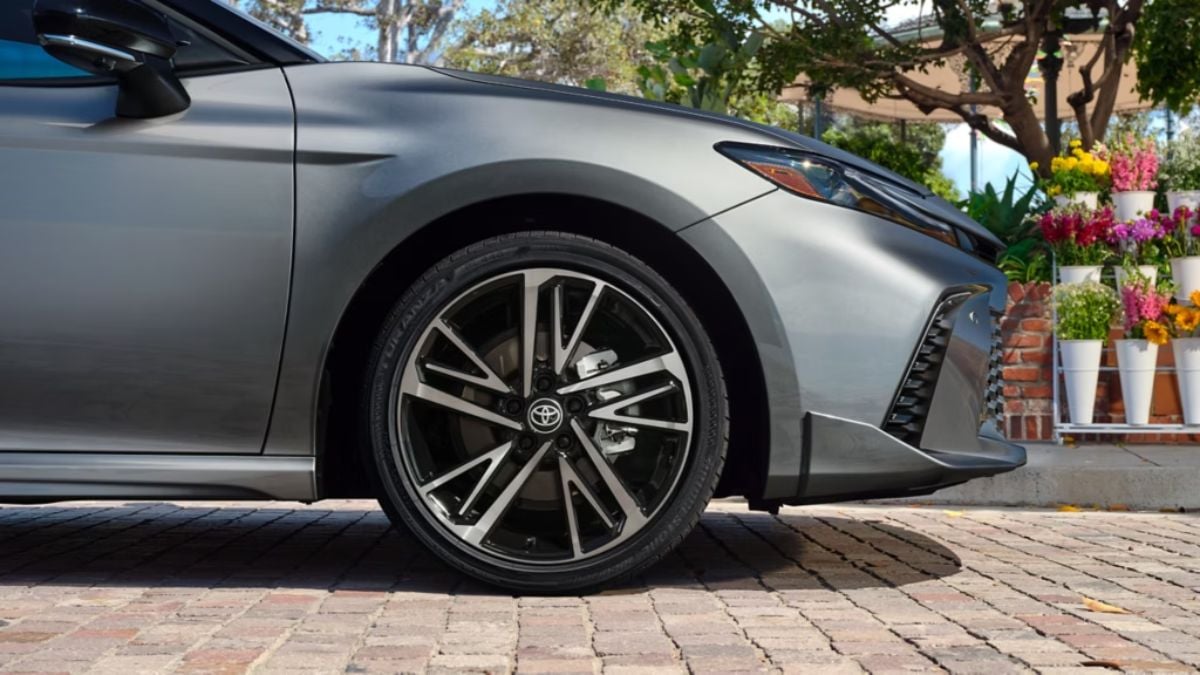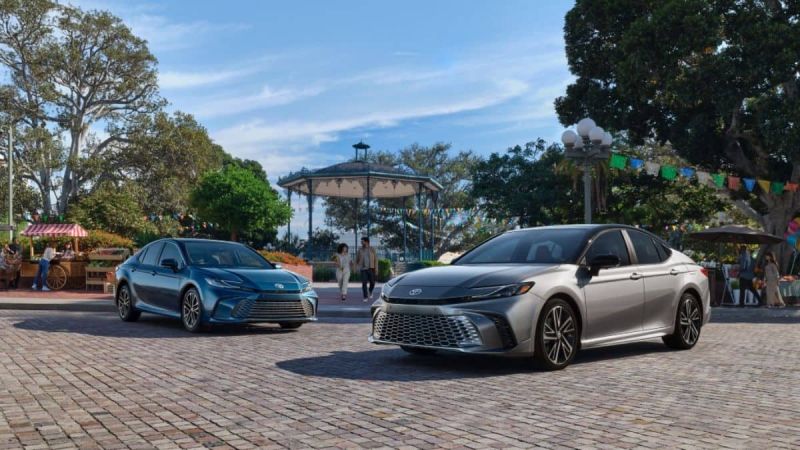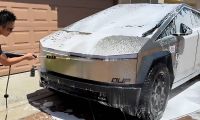Most of us expect that a check engine light is no big deal when it comes on within the first 20k miles. It might mean a loose gas cap or a fussy sensor. That’s what makes what happened to Nick Godfrey all the more surprising. While I found myself in the “2025+ Toyota Camry 9th Generation Owners Club” on Facebook, I came across his story: a seemingly routine visit for a light on the dash turned into a warranty denial over rodent-chewed wiring. Nick had taken in his 2025 Toyota Camry SE expecting a quick fix. But instead he left with unsettling evidence of shredded wires and a new insurance claim he never planned to file.
Here’s how Nick explained the situation in his own words:
"I got a ‘25 Camry SE with around 18,500 miles. The check engine light came on last week on Friday, so I called the dealer to schedule an appointment. They said to bring it first thing this morning (Monday). I put my code scanner to see what’s going on and it came back with two codes for the oil pressure/temperature sensor. Sensors fail sometimes, it’s no big deal, it’ll be covered under warranty. After waiting about an hour at the dealership, the service advisor comes out with pictures of wires all chewed up and says it’s rodent damage and NOT covered under warranty. They need to keep it for a while to determine whether or not it’s repairable or if the harness needs to be replaced and inspected for more damage. I’ve lived in this house for over 12 years and had over a dozen cars between the wife, the kids and myself and NEVER seen “rodent damage”. I’ve never seen a mouse or anything of the sort around here! The service advisor tells me that he’s heard that Toyota seems to have this happen more often than other brands and that there’s something in the wires that attracts rodents… This falls under comprehensive coverage with my insurance, but just what I need is a claim on my policy for all this…we already get bent over on insurance in Michigan as it is. So, keep an eye out for mice chewing up your electricals; according to this guy, Toyota has this happen often but they’re not going to cover it if it happens. Also, I’ve got a Hyundai Sonata for a rental and it seems like a nice car."

Rodents, Wires, and a Growing Problem
Nick’s frustration is more common than it may seem. Modern vehicles, especially those using eco-friendly soy-based wiring insulation, are increasingly falling victim to rodents that seem to love chewing through critical components. Toyota, along with other automakers like Honda and Subaru, have been quietly at the center of this debate. And for some drivers, the situation is worse than expected like in this story about a 2025 Toyota Camry that's been in the shop four times, with no clear fix in sight.
Mitch Pinson, a commenter under the post, was one of the first to chime in to offer his thoughts: “Darn. I'm curious how much it will all cost when they're finished repairing it and if it's worth a claim on your insurance.”
That’s a valid concern, especially when the damage might extend to hard-to-reach or expensive components like the engine control harness. Insurance can help, but at what cost to future premiums?
Clayton Sorensen added some eye-opening context: “I know Hyundai uses eco-friendly soy beans to make the insulation for their wiring harness. I used to work for a company that managed a fleet of 250K vehicles and rodents loved munching on Hyundais and the repairs normally cost in the thousands. I wonder if Toyota went the eco route on their wiring insulation as well.”
There’s growing suspicion among owners that Toyota has indeed adopted similar materials. This could explain why stories like Nick’s keep popping up. In fact, as Clayton pointed out, hybrid variants tend to fare even worse. Other issues were also echoed in another story about squeaky Camrys and transmission complaints, where owners discovered underlying issues far more complex than they expected.
Nadia GM, commenting from Canada, shared a larger-scale perspective: “Here in Canada, there is a huge recall and lawsuit on certain Honda vehicles because the casing around the wires were made with a base of soy that attracts rodents.”
Her insight speaks to how widespread and serious the problem has become. Lawsuits and recalls tied to rodent-prone wiring are no longer rare, yet they remain poorly understood by most consumers.
Joe Tagliavia’s experience adds even more gravity: “We had $13k damage to our Toyota Sienna earlier this year. They got the main engine harness and more. That's an $8k part. I paid out of pocket for rodent tape on all harnesses as a preventative. And now, I look under my hood once a week.”
Preventative measures like rodent tape and weekly inspections might sound extreme, but for people like Joe, they’ve become necessary habits to prevent future problems after big bills like that. Given that some owners report recurring issues even after repairs, this isn’t just about a single bad incident as it’s about adjusting to a new reality of ownership it seems.
A Bigger Pattern With Camry Ownership
And here’s the twist: this isn’t even the first time Toyota owners have voiced concerns over unexpected expenses. Camry drivers are starting to realize that ownership comes with more complications than advertised.
One driver recently shared their experience dealing with frustrations shared after six months of owning a 2025 Toyota Camry, pointing out that issues often fall through the cracks despite appearing minor. Meanwhile, a different post revealed how sudden insurance surprises after a delay in coverage affected the ownership experience.
To put it in perspective, a Toyota technician even offered a detailed review of the 2025 Camry, revealing both strong points and hidden weaknesses adding another layer of insight to the complexities of the Camry.
Why This Story Reflects a Bigger Shift
In the middle of all this, Nick finds himself behind the wheel of a Hyundai Sonata rental and he admits it’s surprisingly nice. It’s a subtle but telling moment that sometimes it takes a service visit gone wrong for owners to see how other brands measure up, even if it’s just from the driver’s seat of a loaner. When your car is sidelined by something as small as a mouse and the brand won’t cover it, the experience in a competitor’s vehicle, even a temporary one, can leave a lasting impression.
I believe stories like Nick’s remind us that car ownership today is about more than just engines and MPG as it’s about understanding the unseen risks too. We spend so much time researching trim levels, tech packages, and resale values that we often overlook something as simple and devastating as a hungry rat under the hood. It’s a strange reality where a modern, $30,000 vehicle can be brought to its knees by something as small as this. And the fact that these types of failures are labeled as “not our problem” by the automaker tells us something about how warranty systems are still playing catch-up with the challenges of modern materials and eco-focused designs too.
Key Takeaways for Toyota (and Other) Owners
- Rodent damage likely isn’t covered under warranty for most automakers, so assume responsibility even if you’re under mileage or time limits.
- Soy-based wiring insulation may be contributing to this issue, and it’s not unique to Toyota. Ask your dealer if your vehicle uses such materials.
- Check your insurance coverage for comprehensive clauses that include rodent damage. Filing a claim may help, but it could also raise your premiums.
- Preventative solutions exist, like rodent tape, peppermint sprays, or even hood inspections every week or two. They may seem tedious but could save you thousands in the long run.
- Read the fine print on what your warranty actually covers. Surprises like these often come down to technicalities and not mechanical fairness.
Now We Want to Hear from You
Have you ever dealt with rodent damage on your vehicle? And did your automaker cover it or leave you hanging?
Do you think automakers should re-engineer their materials to prevent this, even if it means stepping away from eco-friendly designs?
I'd like to hear your take in the comments below, so don't hesitate to share.
Aram Krajekian is a young automotive journalist bringing a fresh perspective to his coverage of the evolving automotive landscape. Follow Aram on X and LinkedIn for daily news coverage about cars.
Image Sources: Toyota Gallery













Comments
Our 2015 Honda CRV and 2010…
Permalink
Our 2015 Honda CRV and 2010 Ford Edge both had rodent damage to wiring and other components when they were new. It was squirrels that had a taste for wiring and other components made from Soy. We had our cars to the shop 3 times for about $3000 damage to repair chewed wiring, windshield washer tubing, headlight housing and the battery box all chewed up by squirrels. Insurance covered 90% as we had a $100 deductible. Honda told me too rodent damage wasn’t covered under warranty. This is not a new problem by a long shot.
It IS A MANUFACTURING DEFECT and should be covered by a warranty if they continue to make wiring and other automotive products rodents find tasteful by using soy based additives. Honda knows it has a problem as it has rodent tape to discourage rodents from chewing on wiring. Why can’t manufactures add Capsaicin to the wiring shielding and other plastics that don’t taste good to rodents? That’s what rodent tape has in it.
It should also be noted some of our neighbors at the same time had similar damage from squirrels. Several lawsuits have been filed against auto manufacturers. Not sure what the end result was of those lawsuits.
We still have both cars and squirrels haven’t bothered either one now for about 7 years. I guess old dirty wiring and old dirty plastic doesn’t taste so good anymore. Maybe I just jinxed myself.
Thanks for sharing all that…
Permalink
In reply to Our 2015 Honda CRV and 2010… by Brandt Leischner (not verified)
Thanks for sharing all that Brandt.
It's eye-opening how common this issue really is. You make a great point about the soy-based wiring and the need for manufacturers to take more responsibility. It really shouldn’t be up to owners to solve a design flaw like that.
That's a common myth. There…
Permalink
In reply to Our 2015 Honda CRV and 2010… by Brandt Leischner (not verified)
That's a common myth. There's no evidence to support the claim that soy based insulation increases the rodent damage. There's no defect.
I had some wiring damage due…
Permalink
In reply to Our 2015 Honda CRV and 2010… by Brandt Leischner (not verified)
I had some wiring damage due to rodents on my 2005 Cadillac CTS. I bought mouse repellant from Lowe's. It looks like a big teabag and I tape it under the hood. Be
En a few years now with no problems
Smart move Paul. Those…
Permalink
In reply to I had some wiring damage due… by Paul Martin (not verified)
Smart move Paul.
Those repellents are a great low-cost way to keep rodents out. Glad to hear it’s worked for years under the hood of your CTS.
I am an owner of a 2023…
Permalink
I am an owner of a 2023 Honda CRV and after about 6 months of ownership I experienced my windshield washer was not functioning. The dealership found that a rodent had chewed the fluid line and was making a nest in the cabin filter. After a $600 bill and a screen installed over the filter there I have had no problems since. I do spray the engine compartment regularly with peppermint spray.
I also have an issue with screeching rear brakes when backing up first thing in the morning. They stop doing it after driving for a while.I mention it every time I take it in for service and am told each time that Honda knows about it but has not come out with fix yet. They must be waiting for me to get enough miles on it that I will need the brakes replace due to wear. Then it will be on my dime.
Owned a 2012 CRV with 134,000 miles on it prior to trading for the 2023 and never had a single problem with it. Must say I do love my 2023 CRV too.
Thanks for sharing your…
Permalink
In reply to I am an owner of a 2023… by Ellis Tucker (not verified)
Thanks for sharing your experience Ellis.
Sounds like you’re doing everything right to keep the rodents away. The brake noise situation is frustrating though, especially when it’s a known issue. Hopefully Honda steps up with a proper fix before wear puts it on you.
Of course the warranty doesn…
Permalink
Of course the warranty doesn't cover rodent damage. There's no manufacturing defect!
Standard insurance covers such damage.
Sanibel Island Florida has…
Permalink
Sanibel Island Florida has lots of cases where rodents chew the wires. It is directly related to the use of soy based wire insulation. Thousands of dollars to fix, covered under insurance (for now). Online you can buy a sonic device that keeps the rodents away. Rat traps in garage also help.
Yes! There's definitely…
Permalink
Yes! There's definitely something that Toyota is using to attract these rodents. I'm on my 4th Camry over a 20 year span. I had a 2020 Camry SE AWD and discovered that when I took my car in for an oil change that a rodent had began making a nest up under the engine cover. I've lived in the same house over this span and that was the first vehicle that I or my wife has owned in which a rodent has made a home in the Camry. Mind you that the car is driven approximately every single day 30-35 miles from home to work. Luckily I monitored the situation pretty much every other day and the little pesky rodent kept getting up in there.I eventually had to spray peppermint oil under the engine cover and place paper towels sprayed with the peppermint oil throughout various sections under the hood. Unfortunately I also had to put blocks of rodent prevention around where I parked the car. That seemed to get rid of whatever rodent it was. I now have the 2025 Camry XLE and so far no issues but unfortunately I still check up under the hood once a week which is frustrating as hell but necessary. I hope whatever materials Toyota is using in there newer cars that's attracting these rodents will no longer be considered.
Glad the peppermint oil…
Permalink
In reply to Yes! There's definitely… by Shawn G (not verified)
Glad the peppermint oil worked for you Shawn. Hopefully your 2025 stays rodent-free!
With the amount of tech…
Permalink
With the amount of tech bloat and associated wiring involved with it, this is just proof that you should not use bacon flavored loom over wiring.🤷🏼♂️
This rodent issue happened…
Permalink
This rodent issue happened to me twice already. Each time costing about 9k. I am grateful to GEICO because they covered it both times with no hassle or questions. Also in 20 years it has never happened but now in a period of 3 years it happened twice on my hybrid Lexus Rx450. No neighbors behind and it is all bushes and stuff which the association takes care of. I should note that we also see many rabbits around. My neighbor caught a big rat using a trap right next to his front door. I also caught one on the side of the house using a trap and one using a large sticky mat. I got 2 cats but they’re useless because they’re indoors and they rather destroy my furniture than go outside searching for Jerry. Anyways now I use peppermint spray under the car every few nights and also I have a blinking light on the floor which I removed from a cheap toy. Hate these rodents with a passion.
That’s brutal Barry. Two $9k…
Permalink
In reply to This rodent issue happened… by Barry (not verified)
That’s brutal Barry.
Two $9k hits in three years is wild. It really seems like hybrids are more vulnerable, and the environment you described sounds like rodent paradise. Glad GEICO came through, and your blinking light trick is actually pretty clever!
As a former Toyota…
Permalink
As a former Toyota technician I must say I found this article a waste of time. Of course animals causing destruction to your vehicle, this falls under your insurance. That being said it is the owners responsibility to make sure they have the correct coverage not Toyota. I have repaired and replaced entire engine and interior harnesses that had rodent damage and were covered by insurance. This s doesn't come down to a Toyota issue in the slightest.
Rodents chewing wires isn't…
Permalink
Rodents chewing wires isn't specific yo Toyota, and it isn't a new phenomenon. And why would the warranty cover damage not caused by the manufacturer?
I have a2024 rav4 and i have…
Permalink
I have a2024 rav4 and i have rodent damage to the high voltage lines only old has 3000km an based in Ireland
I had $15000 in rodent…
Permalink
I had $15000 in rodent damage. It was covered by insurance but my rates increased by $100 per month.
2019 Honda Accord, new…
Permalink
2019 Honda Accord, new wiring harness, twice. Another Honda Accord Hybrid 2023, both leased, now 2nd harness for mice or rat damage, Mercury is taking more than a month on this second one.
My 21 jeep cherokee had the…
Permalink
My 21 jeep cherokee had the wires chewed months after purchasing. Now I leave the hood up and check it every few days for signs of rodents.
They sell a rodent…
Permalink
They sell a rodent preventative spray on amazon..I spray my engine bays at least 2x a tear. Cinnamon and other essential oils that's supposed to deter rodents. No issues here. To me it smells nice too but you don't smell inside the car
This is a problem auto…
Permalink
This is a problem auto manufacturers have fought for decades. It is negligence when an auto manufacturer uses wiring with insulation that rodents like. Recalls have been forced for it. They absolutely might be liable.
I feel that if the auto…
Permalink
I feel that if the auto makers are using soy based wiring, they should have to cover the rodent damage in their warranties. If you supply bait that attracts animals, you should have to pay for the damages when the eat it.
Rodents have caused over $3…
Permalink
Rodents have caused over $3,500 in repair bills for my Tractor and Airstream Trailer. They chew wires, fuel hoses, hydraulic hoses and brake hoses. So far no damage to my cars, but just a matter of time. I was in NYC and some ladies car would not start. We open her hood and first thing I see is a Rats nest under her good. Rat chewed on all her ignition wires.
It's all non USA vehicles…
Permalink
It's all non USA vehicles. My 2018 Mercedes AMG had over $5500 in rodent damage. It was a mess! And the cleanup from all the rodent droppings throughout the vehicle continues to this day almost a year later!
The authorities should make…
Permalink
The authorities should make all car manufacturers recall all vehicles with this defective wiring and replace it with suitable wiring which doesn’t attract rodents, free of charge.
This could be a safety issue if it caused a fire or a breakdown in an unsafe location & should be taken very seriously.
Had a 2019 RX350 that…
Permalink
Had a 2019 RX350 that squirrels ate the front bumper sensor wiring. Fortunately, they removed the bumper and were able to splice the wire harness. It _ONLY_ cost me $1200. I feel lucky after reading some of these stories. They also got my garden tractor harness.
I have those green poison…
Permalink
I have those green poison blocks in the underside of my dash because I've seen mice in my tundra so much. It definitely helps but you shouldn't have to worry about something like that.
I agree Michael. As much as…
Permalink
In reply to I have those green poison… by Michael (not verified)
I agree Michael.
As much as it's nice to see that you're taking the appropriate precautions, it would be even better to not have to deal with this in the first place.
I have a 2024 Hyundai Kona N…
Permalink
I have a 2024 Hyundai Kona N-line. I have also had this problem. The rodent went nuts in my engine $17,000 worth of damage. Not covered by warranty. Ridiculous they built the car with these wires. That should have to fix it under warranty!!
Pagination